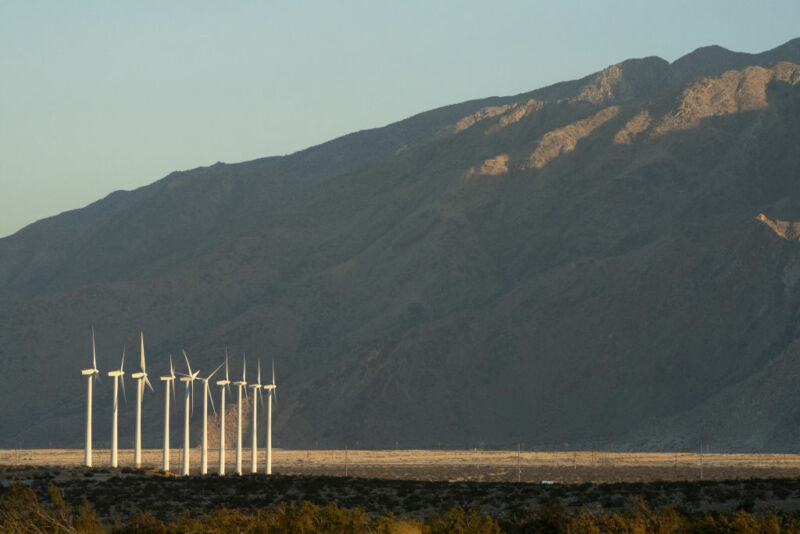Wind power doesn't make up the largest part of the United States' energy mix, but it grew over the last year, according to the Wind Technologies Market Report. The renewable energy source grew to more than 8 percent of the country's electricity supply—reaching 10 percent in a growing number of states—and saw a whopping $25 billion in investments in what will translate to 16.8 gigawatts of capacity, according to the report.
Released by the US Department of Energy, the sizeable report draws on a variety of data sources, including government data from the Energy Information Administration, trade data from the US International Trade Commission, and hourly pricing data from the various system operators. “The report itself covers the entire gamut of the US wind industry,” Mark Bolinger, a research scientist at Lawrence Berkeley National Laboratory and one of the authors of the report, told Ars.
Bigger is sometimes better
According to the report, the performance of wind power operations in the US has improved a great deal. We can measure this metric based on capacity factor, a ratio of the amount of energy a turbine actually produces compared to the amount it could have produced if it ran at its peak constantly. For recently constructed wind power projects, the average capacity factor has now cleared 40 percent. The biggest gains in this area, however, are seen in the US's “wind belt,” a region stretching from the Dakotas to Texas that receives a large amount of wind.
In large part, this increase is due to longer blades, which allow the turbines to generate more power as they're spun around by the wind. According to the report, in 2010, there were no turbines in the US that had rotors at or above 115 meters in diameter. However, last year, 91 percent of new turbines had rotors of this size or larger. The report also notes that this size is likely to increase.
The towers these rotors are attached to are also getting taller, sometimes along with the increase in blade size. According to Bolinger, this move isn't quite as widespread, but “it is starting to creep up now.”
In the past, there's been a “soft cap” of 500 feet on the total height of the turbines—from the base of the tower to the tip of the blades—because that triggers greater permitting requirements from the Federal Aviation Administration, he said. But with the size of the rotors increasing recently, the size of the towers themselves also needs to increase to avoid having the blades swing too low to the ground. Developers have gotten more comfortable going over 500 feet, he said, adding that some turbines are reaching 700 feet tall. Even besides the practical reason behind them, taller towers also help the turbines generate more energy.
“In general, the winds tend to be stronger at higher altitudes, so this is something that will increase the capacity factor,” he said.
The “wind belt” still sees the vast majority of wind development in the US. However, this trend of larger turbines with larger rotors allows wind operators to function quite well in areas that have lower average wind speeds. “That does open up other parts of the country to economical wind development,” he said.
There are larger up-front costs to build these larger turbines, but at a dollar-per-watt basis, they end up cheaper. They may be more expensive, but they produce more energy, Bolinger said.
Blowin’ in the wind
All of this is making wind power cheaper. In 2009, the national average price of wind power purchase agreements reached a peak of $70 per megawatt-hour. Now, in the “wind belt,” it is around $20 per megawatt-hour and averages around $30 per megawatt-hour in the country's eastern and western regions. “These are at, or near, all-time lows,” Bolinger said, although they include the impact of renewable energy tax breaks.
Wind also gets indirect subsidies, since it requires power lines to get to people. Wind operations tend to be located far away from major population centers. Bolinger said that, to improve the effectiveness of wind power, there should be better incentives to build these lines and more planning involved in building them.
“You need that critical transmission link to move the power from the wind farm to the urban centers where the power can be consumed,” he said.
Wind's growth has come in part due to tax breaks and the willingness to pay the costs of expanding the transmission grids. But it also provides benefits that aren't priced in, either. By displacing fossil fuels, wind power can reduce the emissions of various compounds such as carbon dioxide, nitrogen oxides, and sulfur dioxide, among others. Human health and the climate benefit from these reductions. The report estimates that the national average economic benefits for these reductions came to $76 per megawatt-hour generated by wind last year. According to Bolinger, this year's report is the first that includes a segment about the health and environmental benefits of the renewable energy source.



3175x175(CURRENT).thumb.jpg.b05acc060982b36f5891ba728e6d953c.jpg)

Recommended Comments
There are no comments to display.
Join the conversation
You can post now and register later. If you have an account, sign in now to post with your account.
Note: Your post will require moderator approval before it will be visible.